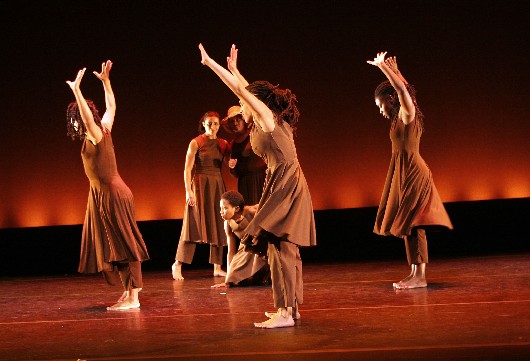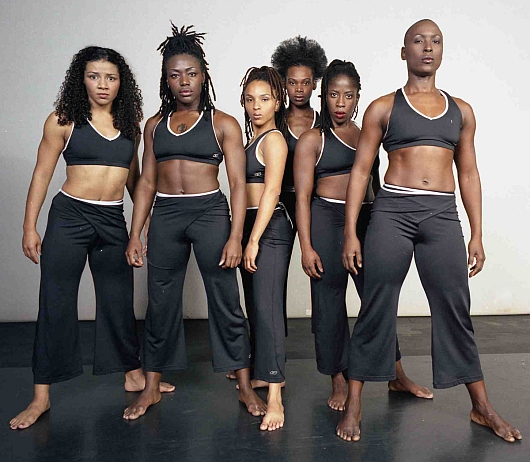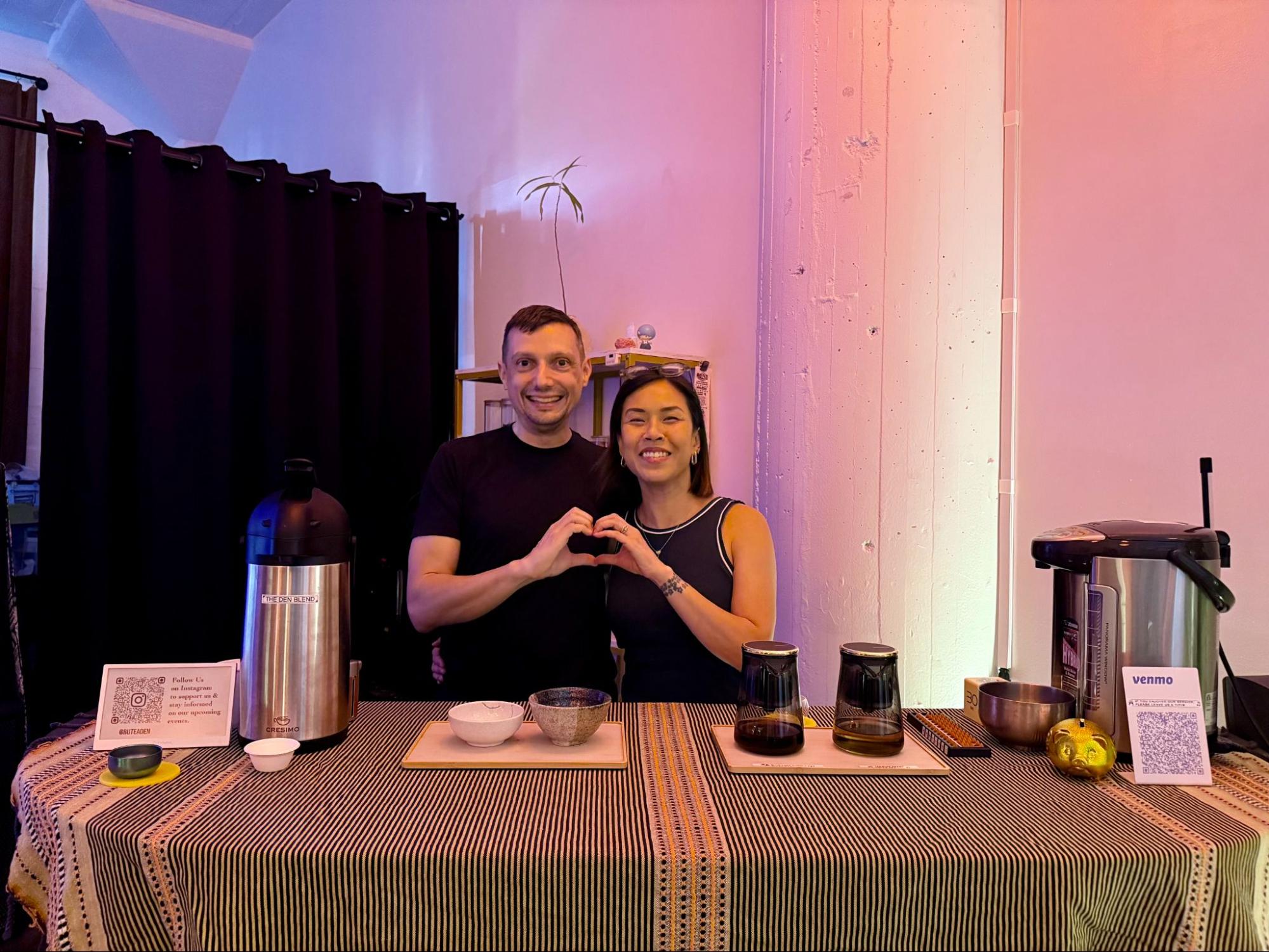
UBW Maria Bauman, Christal Brown, Nia Eubanks, Chanon Judson, Francine Sheffield, Nora Chipaumire. Photo by Lea Rudee.
"For Urban Bush Women, creating dance and creating community are essentially linked. Founded in 1984 by choreographer Jawole Willa Jo Zollar, Urban Bush Women seeks to bring the untold and under-told histories and stories of disenfranchised people to light through dance. We do this from a woman-centered perspective, as members of the African Diaspora community, in order to create a more equitable balance of power in the dance world and beyond."
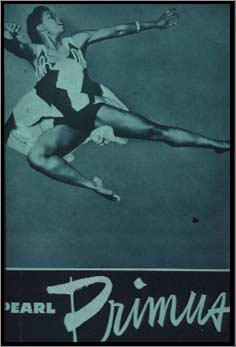
Backed-up by crickets and the sticky aroma of ebony nights, Pearl Primus' carnal specter, impersonated by Jawole Willa Jo Zollar, gracefully skims the stage floor, fore-limbs set in motion with the command and precision of a Time Machine hurling us back to the 1940's. These subtle steps begin "Walking with Pearl... Africa Diaries."
First seen in Trinidad in 1919, then raised in NYC, Pearl Primus was a teacher cum dancer cum choreographer cum student of Central and Western African, plus Carribean, dance, and recipient of an M.A. in Education AND at the age of 59, a Ph.D. in Anthropology. This phenomenal woman's spirit descends upon Jawole Willa Jo Zollar as she sits her opiniated tush down to lecture from Pearl's African chronicles, illustrated by the Urban Bush dancers' virtuoso steps.
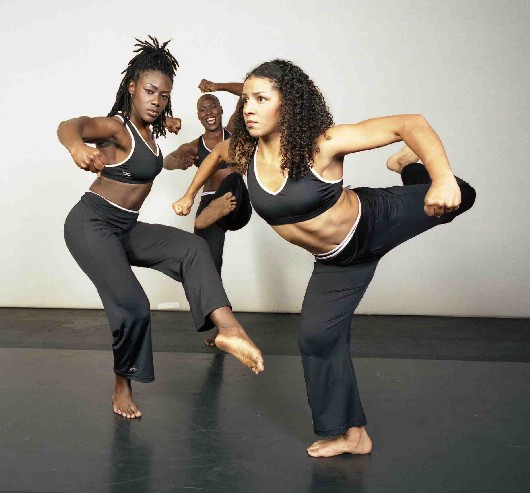
Adorned in fluid crimson, mango, and leaf-colored robes, these magnificent chameleons float in the wind like wild reeds, spring forward like panthers, rise on hooves with the grace of gazelles reaching up to the sun, roll around like cubs playing in the savanna dirt, assert their dominance with chest-puffing and wing-shaking, all joined in unison to celebrate Pearl's Mother Africa, a haven of natural beauty and harmony. "Dance is a fist with which I fight racism." This meaningful and dynamic chant emboldens, but Pearl's incantations, vocalized by Zollar in an increasingly melodramatic tone, also threaten to overpower the dazzling sight of the prancing queens.
The stage grows darker, the dancers shed their animal skin...
A couple embraces, recalling the birth of the human spirit. African strings serenade the pirouetting mavericks as they form the safe embrace of a nurturing cirle. Each performer takes a turn affirming her individuality as a creature of air, fire, water, and earth; both voluptuous and muscular, of the spirit and of the flesh; teacher, warrior, seductress, giver, and taker of life.

Photo by Christopher Duggan.
During intermission, Jawole Willa Jo Zollar, founder of UBW, introduces the second segment, "Walking with Pearl... Southern Diaries." I'm hoping Pearl's weighty verses won't intefere with the dancing this time. But J. Zo informs us we should expect shouting, as in ring shout. I'm totally won over by the Master Choreographer's ecstatic spirit as she leaves the stage jubilating over UBM going on their 23rd year, 24th, 25th...
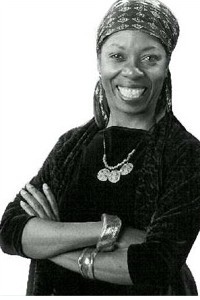
Jawole Willa Jo Zollar
Pearl Primus began her performing career during the Jim Crow years, under the myriad 'Whites Only' signs and summary random executions, bookended by beatings, maimings, lynchings, and live burnings. She was an African and an American. A dancer and an activist. She often performed to poetry: Langston Hugues' "The Negro speaks of Rivers," and Lewis Allen's protest song "Strange Fruit," juxtaposing graphic descriptions of a body hanging from a poplar tree with references to the "gallant" South. In the aftermath of degrading Minstrel shows, Black face, and the Uncle Toms of the era, maybe dance alone wasn't enough for Pearl. Maybe she wanted to make a point that she wasn't there solely to entertain, but to educate, oppose oppression, and demand change as well.

Pearl Primus (1919-1994)
In "Walking with Pearl Primus... Southern Diaries," the stage turns a gorgeous terra cota hue, like a fiery sunset or red clay at the bottom of the Mississipi Delta. From this rich material, Jawole Willa Jo Zollar creates a series of tableaux more anchored in experience than in "Walking with Pearl... Africa Diaries," with its idealized version of a peaceful Africa from which the ravages of disease, droughts, dictatorships, civil wars, and colonization were absent.
Dressed in coarse maroon dresses over pants, the Southern women ride the ominous Jim Crow train in cotton fields, churches, Saturday Night dance halls, and protest marches. The dancers no longer morph into animals or plants, but are women rooted in the ground, hips stretching wide as a magnolia tree to sustain the load of oppression and hard labor. Gone is the freedom of movement experienced in the African diaries, the women are physically and emotionally closer, gathering in groups at the first sign of a threat, conjuring the Holy Ghost, and stomping the enslavement blues with clapping, shouting, and hysterical laughter.

Photo by Carol Pratt/Kennedy Center for the Performing Arts.
The voice of Nina Simone suddenly sings of trees bearing strange fruit, bringing these mighty hip-shakers' indomitable bodies and spirits to a halt. One of their sisters watches helplessly as her loved one is brutally hung with no trial. The warriors quickly rally around her grief, feet sinking into the clay of despair, no law to protect nor serve them, but the oft-elusive Law of God .
With muted cries and an unbearable grimace, a bereaved woman, encouraged by her sisters, uses every part of her miraculous body to shake out the insufferable pain in a display of courage and strength that challenges the definition of African Americans as victims of slavery. The defiant spasms sum up the words of no-nonsense music historian Albert Murray, from his exhilarating "Stomping the Blues," as he challenges White historians' assertion that the Blues "bore the stigma of the yoke of slavery." Instead Murray writes, "for some curious reason, nothing at all is ever made of the possibility that the legacy left by the enslaved ancestors of blues-oriented contemporary U.S. Negroes includes a disposition to confront the most unpromising circumstances and make the most of what little there is to go on, regardless of the odds - and not without finding delight in the process or forgetting mortality at the height of ecstasy."
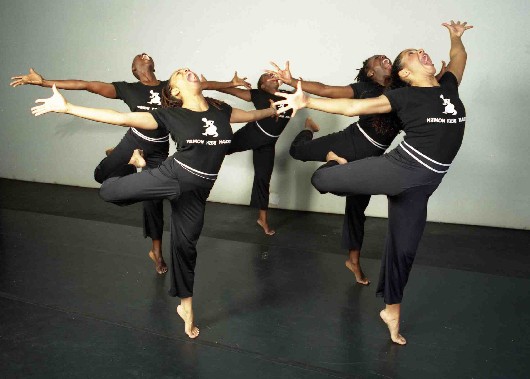
The Intimate Theater at the Luckman Fine Arts Complex would have been a better venue than its Big Brother, the Luckman Theatre, which boasts to have "one of the largest stages" in Los Angeles. A smaller space would have fulfilled the UBW's mission to create community by bringing us into the circle.
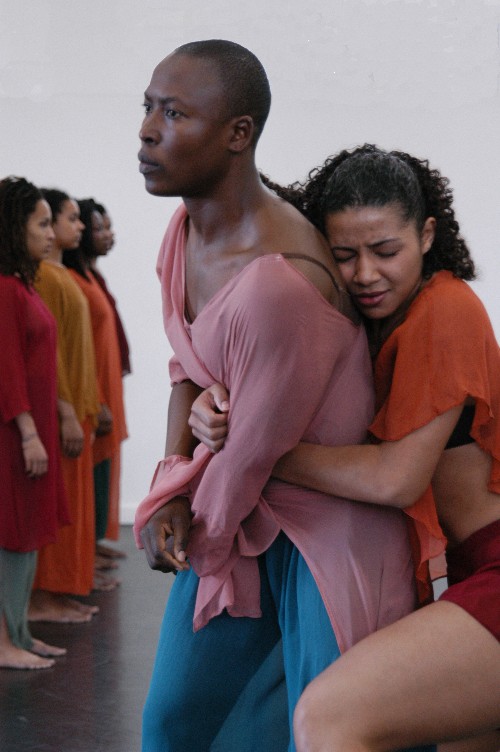
Nora Chipaumire and Maria Bauman. Photo by Christopher Duggan.
With a name like Urban Bush Women, I expected a more contemporary take on race relations in America. In the1940's, "Strange Fruit" was revolutionary, in 2007 it's a song that has been used many times in plays about the segregated and brutal South to the point of light-abuse. But UBW is deeply modern, with current projects and past pieces, like "Hair Stories" and "Batty Moves," powerful cases in point.
After learning about Pearl Primus, it's obvious she is a voice that needs to be rediscovered. Besides being a bold and innovative choreographer and dancer, she was a Black woman who successfully built a bridge between America and Africa, not the easiest task; plus an activist of considerable bravery in considerably hard times. Pearl deserves every jump, every kick, every caress, every note from the fantastic tribute Jawole Willa Jo Zollar and her tribe are paying to her. For this and their amazing grace, the Urban Bush Women, acting as Pearl's disciples, got the crowd on their feet applauding, cheering, hollering, whistling, bumping and grinding in delirious appreciation.
